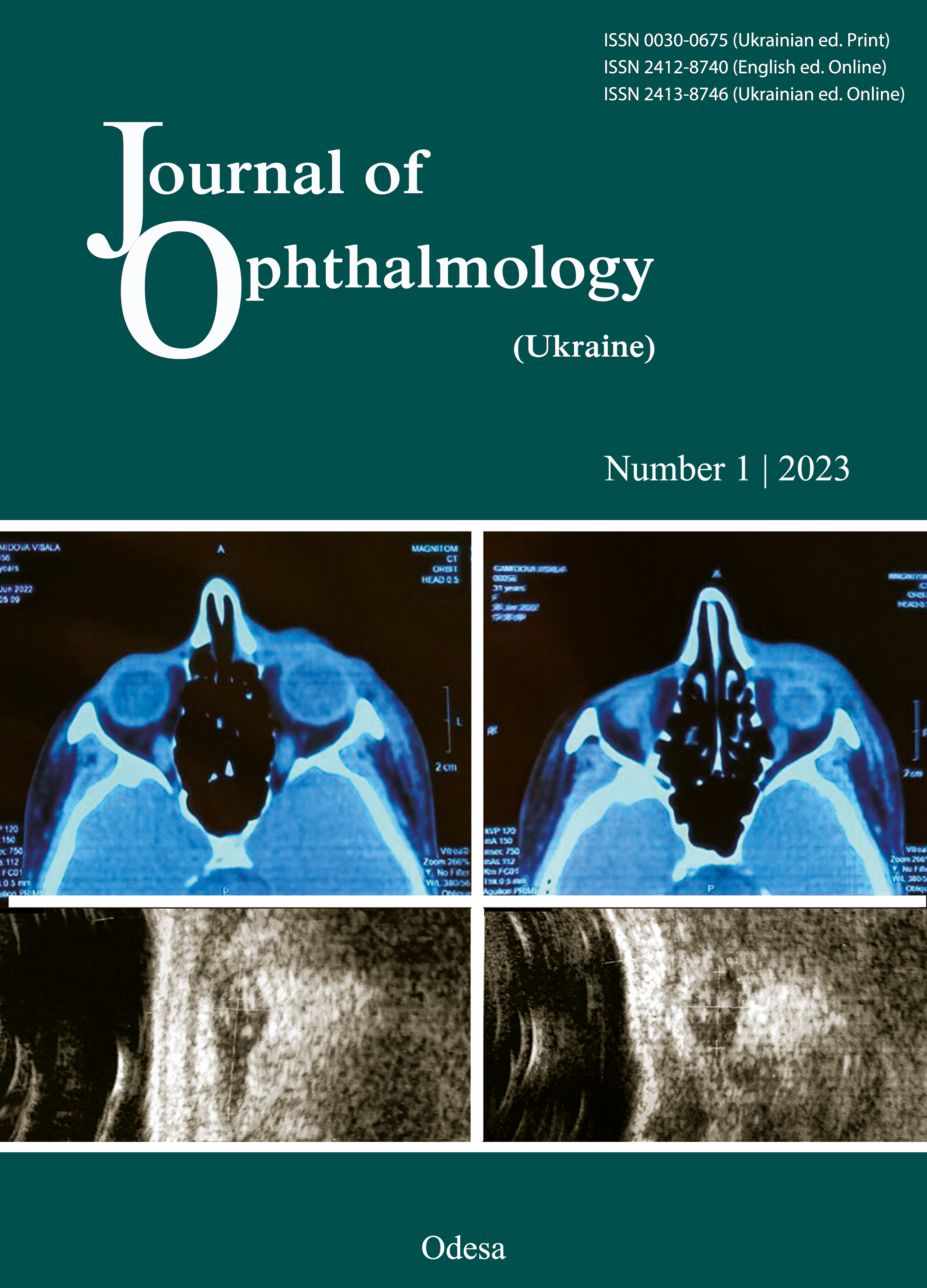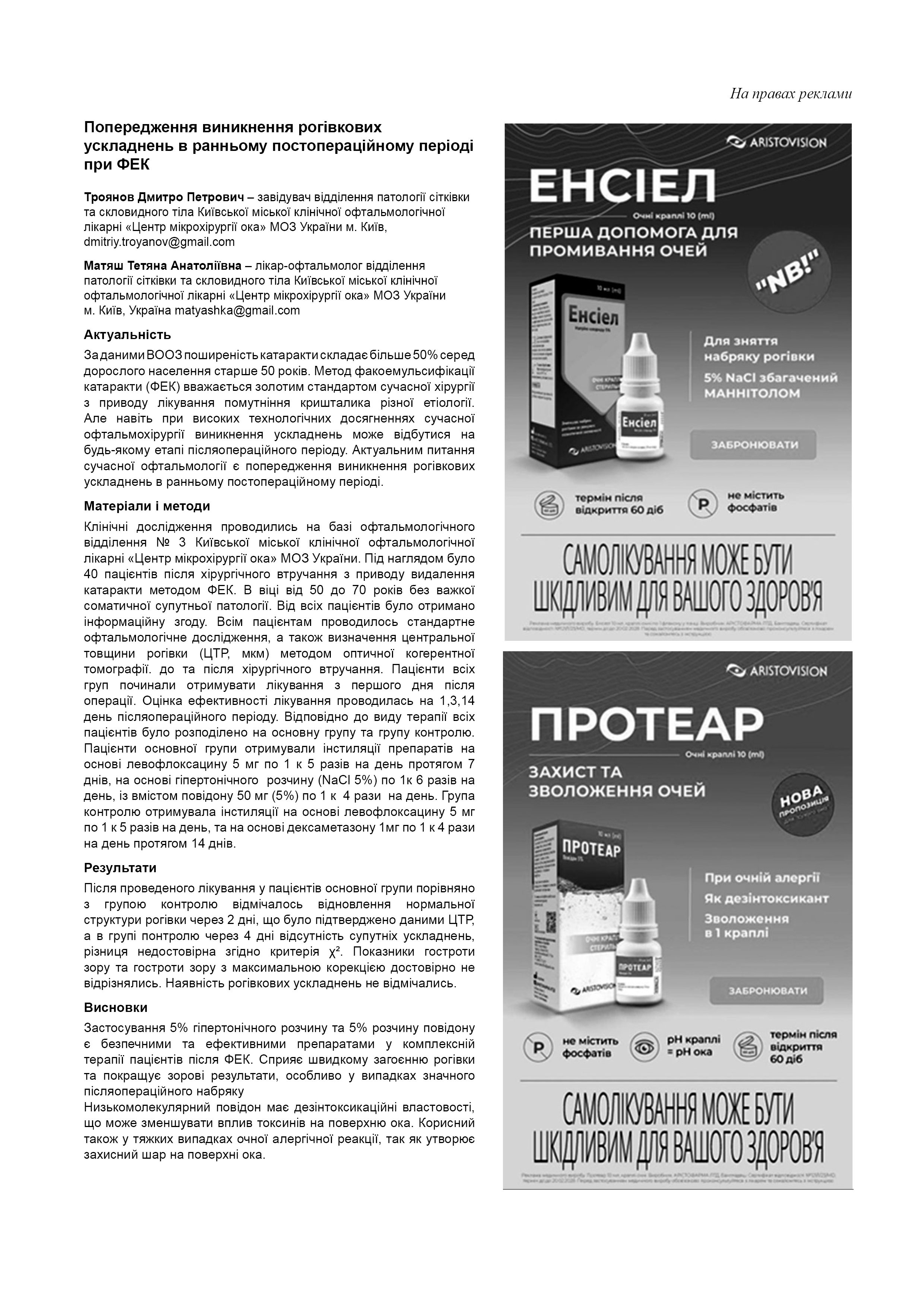Lactoferrin concentration in tears of patients with chronic conjunctivitis and effect of Lacto eyedrops in the multicomponent treatment for this disorder
DOI:
https://doi.org/10.31288/oftalmolzh202313945Keywords:
chronic conjunctivitis, lactoferrin, tear, antimicrobial propertiesAbstract
Background: Lactoferrin (LF) is a non-heme iron-binding glycoprotein of the transferrin family. It is a natural component of the tear film, has bacteriostatic, bactericidal, fungicidal, antiviral, and antioxidant properties, and thus plays an important role in the protection of the ocular surface from infections. A low tear LF concentration has been found in some ocular disorders, but there have been no reports on the determination of LF concentration in tears of patients with chronic conjunctivitis (CC).
Purpose: To determine LF concentration in tears of patients with CC, and to assess the effect of LACTO eye drops in the multicomponent treatment for the disorder.
Material and Methods: Eleven patients (17 eyes) with CC were included in the study. Patient age ranged from 27 to 68 years, and the duration of CC, from 3.5 to 7 months. The ophthalmological examination included biomicroscopy of the bulbar conjunctiva and cornea, fluorescein examination, determination of corneal sensation and basal tear production (Schirmer’s II test), and microbiological examination of the conjunctiva. Corneal and conjunctival xerosis was assessed using the method of van Bijsterveld. Patients were administered a topical antiseptic four times daily, preservative-free hyaluronic acid artificial tears four times daily, and Lacto eye drops twice daily over a month. Concentration of LF in the tear samples was determined by a human LF enzyme-linked immunosorbent assay kit before treatment and at day 30 of treatment.
Results: Seven patients (11 eyes) underwent an examination after the completion of a one-month treatment with Lacto eye drops. Tear LF concentration (mean ± standard deviation (SD)) in patients with CC was 1.37 ± 0.4 mg/ml (95% confidence interval, 1.16–1.58). The examination found no microbial growth in all these 11 eyes, with 6/7 patients presenting no complaints after treatment. There was no statistically significant change in Schirmer II test values from baseline. Corneal sensation was found to be improved in 6/11 eyes. After a one-month treatment with Lacto eye drops, tear LF concentration (a) decreased from a relatively high (mean ± SD, 1.65 ± 0.45 mg/ml) value at baseline to 1.05 ± 0.33 mg/ml (р = 0.04) in four eyes (eyes nos. 1-4), (b) increased from 1.52 ± 0.21 to 2.03 ± 0.41 gm/ml in other four eyes (eyes nos. 6-8, 11), and (c) increased from a low value (0.85 ± 0.17 mg/ml) to 1.18 ± 0.27 (р = 0.07) in eyes nos. 5, 9, and 11.
Conclusion: Lacto eye drops were found to have an immune modulating effect, with any low tear LF at baseline increased in an amount required for normalization of the conjunctival microbiota after treatment. In addition, our microbiological study after one-month administration of Lacto eye drops as a component of therapy for CC demonstrated that the medication provided a sanitizing effect, with no conjunctival microbiota growth but subjective improvement in complaints in all patients.
References
Schneider JE, Scheibling CM, Segall D, Sambursky R, Ohsfeldt RL, Lovejoy L. Epidemiology and economic burden of conjunctivitis: a managed care perspective. // J. Manag Care Med. 2014;17(1):78-83.
Селіванова ОВ. Клініко-експериментальне обґрунтування корекції рівня тіолових сполук в тканині кон'юнктиви та слізній рідині при медикаментозному лікуванні кон' юнктивітів. Дис. канд. мед наук, Київ 2011. 166 с
Моісеєнко РО, Михальчук ВМ, Риков СО. Офтальмологічна допомога в Україні за 2014-2017 роки. Аналітично статистичний довідник. КР-й: ПОЛІУМ». 2018. 314с.
Azari А.А, Arabi А., Conjunctivitis: a systematic review. J Ophthalmic Vis Res. 2020 July-September; 15(3): 372-395.
Benza D. Blephariris and conjunctivitis: Guidelines for diagnosis and Treatment . Barselona: Editoreal Glosa; 2006. 245 с.
Дрожжина Г.И. Конъюнктивит. Клиника, диагностика, лечение, Одесса Астропринт, 2010. 31с .
Поляк МС, Околов ИН, Пирогов ЮИ. Повреждающее действие антибиотиков. Антибиотики в офтальмологии. С.Петербург, 2015: 125-141
Брижань ГА. Профілактика ускладнень місцевої антибіотикотерапії у пацієнтів з синдромом сухого ока. Дис. канд. мед наук, Одесса 2017. 154 с.
Завгородняя НГ, БрижаньАА. Влияние профилактической антибиотикотерапии в хирургии катаракты на цитологический статус эпителия конъюнктивы. Офтальмолгия. Восточная Европа. 2016; 6(1): 14-27
Борзенкова НВ, Балабушевич НГ. Лактоферин: фізико-хімічні властивості, біологічні функції, системи доставки, лікуючі засоби та біологічно активні речовини. Біофарм. журн. 2010; 3: 3-19
Дрожжина ГИ, Великсар ТА. Невидимый защитник глаза - лактоферрин. Український журнал «Офтальмологія». 2021; 1 (12).
Janssen PT, van Bijsterveld OP. Origin and biosynthesis of human tear fluid proteins. Invest. Ophthalmol. Vis. Sci. 1983;24:623-630.
Tsai PS, Evans JE, Green KM, Sullivan RM, Schaumberg DA, Richards SM et al. Proteomic analysis of human meibomian gland secretions. Br. J. Ophthalmol. 2006; 90: 372-377. https://doi.org/10.1136/bjo.2005.080846
McDermott AM. Antimicrobial compounds in tears. Exp Eye Res. 2013;117:53-61. https://doi.org/10.1016/j.exer.2013.07.014
Flanagan JL., Willcox MD. Role of lactoferrin in the tear film. Biochimie. 2009;91:35-43. https://doi.org/10.1016/j.biochi.2008.07.007
Weinberg ED. Human lactoferrin: a novel therapeutic with broad spectrum potential. J. Pharm. Pharmacol. 2001;53:1303-1310. https://doi.org/10.1211/0022357011777792
Ponzini Е, Scotti L, Grandori R, Tavazzi S, Zambon A. Lactoferrin Concentration in Human Tears and Ocular Diseases: A Meta-Analysis. Invest. Ophthalmol. Vis. Sci. 2020;61(12):9. https://doi.org/10.1167/iovs.61.12.9
Kijlstra A, Jeurissen SH, Koning KM. Lactoferrin levels in normal human tears. Br J Ophthalmol. 1983; 67(3): 199-202 https://doi.org/10.1136/bjo.67.3.199
Jensen OL, Gluud BS, Birgens HS. The concentration of lactoferrin in tears of normals and of diabetics. Acta Ophthalmol (Copenh). 1986 Feb;64(1):83-7. https://doi.org/10.1111/j.1755-3768.1986.tb06877.x
Ellison 3rd RT, Giehl TJ, La Force FM. Damage of the outer membrane of enteric gram-negative bacteria by lactoferrin and transferrin. Infect. Immun. 1988;56: 2774-2781. https://doi.org/10.1128/iai.56.11.2774-2781.1988
Oram JD, Reiter B. Inhibition of bacteria by lactoferrin and other iron-chelating agents. Biochim. Biophys. Acta. 1968;170:351-365. https://doi.org/10.1016/0304-4165(68)90015-9
Jagat R, Kanwar I, Kislay R. Multifunctional Iron Bound Lactoferrin and Nanomedicinal Approaches to Enhance Its Bioactive Functions. Molecules. 2015;20:9703-9731. https://doi.org/10.3390/molecules20069703
Vagge A, Senni C, Bernabei F, et al. Therapeutic effects of lactoferrin in ocular diseаses from dry eye disease to infections. Int. Journ. of Mol. Sci. 2020;21(66884):1-8. https://doi.org/10.3390/ijms21186668
Faulkner WJ, Varley GA. Corneal diagnostic tecnique. Cornea: Foundamentals of Cornea and External Disease. Mosby: St Louis, MO. 1997: 275-281.
Yasinska Е, Bogut А, Assessment of the role of staphylococci in the pathomechanism of conjunctivitis. Int Ophthalmol. 2021; 41(7): 2585-2600. https://doi.org/10.1007/s10792-021-01818-w
Jay S Pepose J, Sujata P, Sarda, Wendy Y Cheng, Nora McCormick, Hoi Ching Cheung et al. Direct and Indirect Costs of Infectious Conjunctivitis in a Commercially Insured Population in the United States Klin. Ophthalmol. 2020; 14: 377-387. https://doi.org/10.2147/OPTH.S233486
Epling J. Bacterial conjunctivitis. BMJ Clin Evid 2012;2012:0704.
Orsi N. The antimicrobial activity of lactoferrin: Current status and perspectives. BioMetals. 2004; 17: 189-196. https://doi.org/10.1023/B:BIOM.0000027691.86757.e2
González-Chávez SA, Arévalo-Gallegos S, Rascón-Cruz Q. Lactoferrin: structure, function and applications. Int J Antimicrob Agents. 2009; 33(4): 301.e1-301e8 https://doi.org/10.1016/j.ijantimicag.2008.07.020
Siqueiros-Cendón T, Arévalo-Gallegos S, Iglesias-Figueroa B, García-Montoya I. A, Salazar-Martínez J, Rascón-Cruz Q. Immunomodulatory effects of lactoferrin. Acta. Pharmacol. Sin. 2014;35:557-566. https://doi.org/10.1038/aps.2013.200
Legrand D, Elass E, Carpentier M, Mazurier J. Lactoferrin: a modulator of immune and inflammatory responses. Cell. Mol. Life Sci. 2005;62:2549-2559. https://doi.org/10.1007/s00018-005-5370-2
Versura P, Bavelloni A, Grillini M, Fresina M, Campos EC. Diagnostic performance of a tear protein panel in early dry eye. Mol.Vis. 2013; 19: 1247-1257.
Downloads
Published
How to Cite
Issue
Section
License
Copyright (c) 2023 Drozhzhyna G.I., Riazanova L.Yu., Khramenko N.I., Velychko L.M.

This work is licensed under a Creative Commons Attribution 4.0 International License.
This work is licensed under a Creative Commons Attribution 4.0 International (CC BY 4.0) that allows users to read, download, copy, distribute, print, search, or link to the full texts of the articles, or use them for any other lawful purpose, without asking prior permission from the publisher or the author as long as they cite the source.
COPYRIGHT NOTICE
Authors who publish in this journal agree to the following terms:
- Authors hold copyright immediately after publication of their works and retain publishing rights without any restrictions.
- The copyright commencement date complies the publication date of the issue, where the article is included in.
DEPOSIT POLICY
- Authors are permitted and encouraged to post their work online (e.g., in institutional repositories or on their website) during the editorial process, as it can lead to productive exchanges, as well as earlier and greater citation of published work.
- Authors are able to enter into separate, additional contractual arrangements for the non-exclusive distribution of the journal's published version of the work with an acknowledgement of its initial publication in this journal.
- Post-print (post-refereeing manuscript version) and publisher's PDF-version self-archiving is allowed.
- Archiving the pre-print (pre-refereeing manuscript version) not allowed.



.png)










